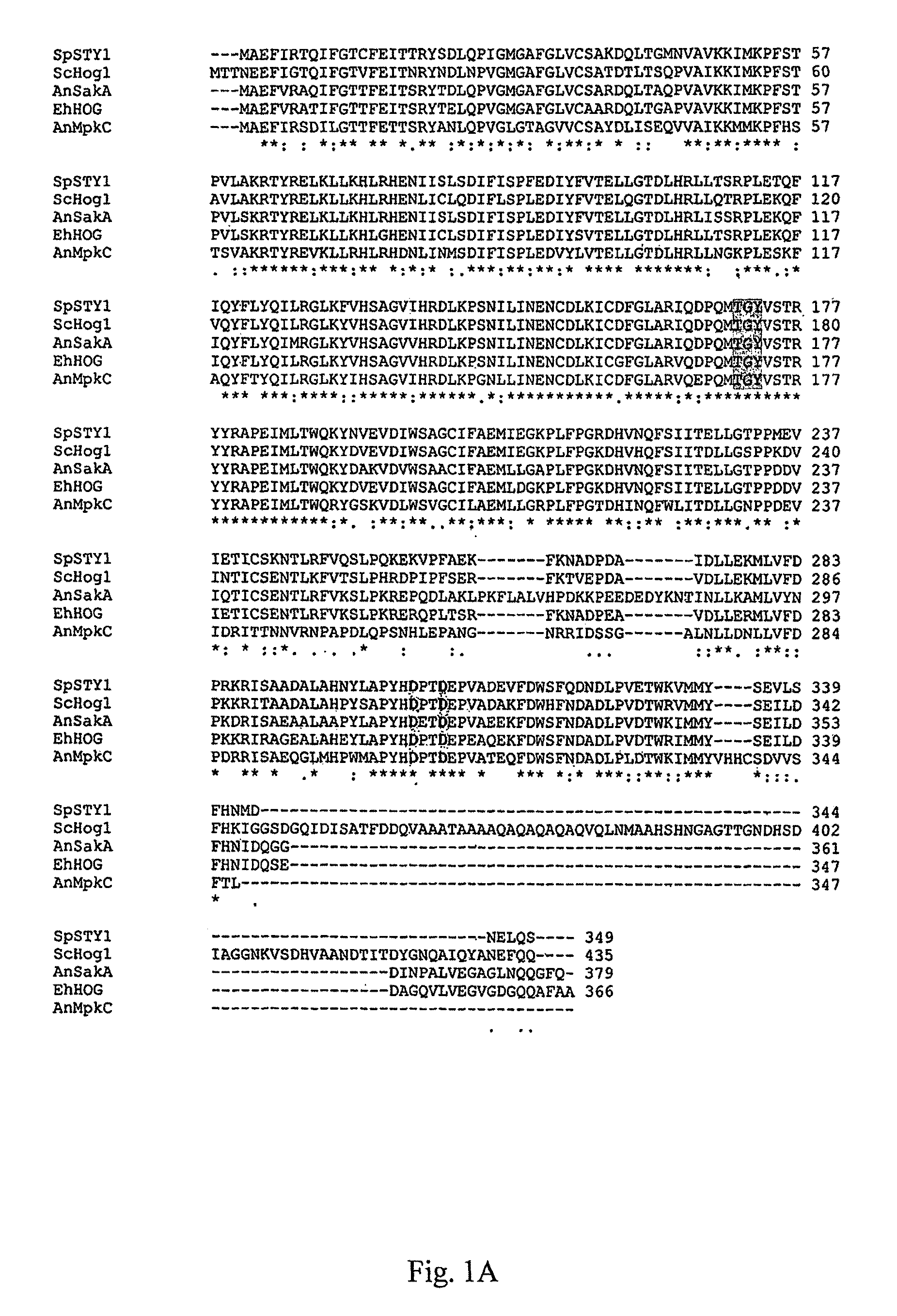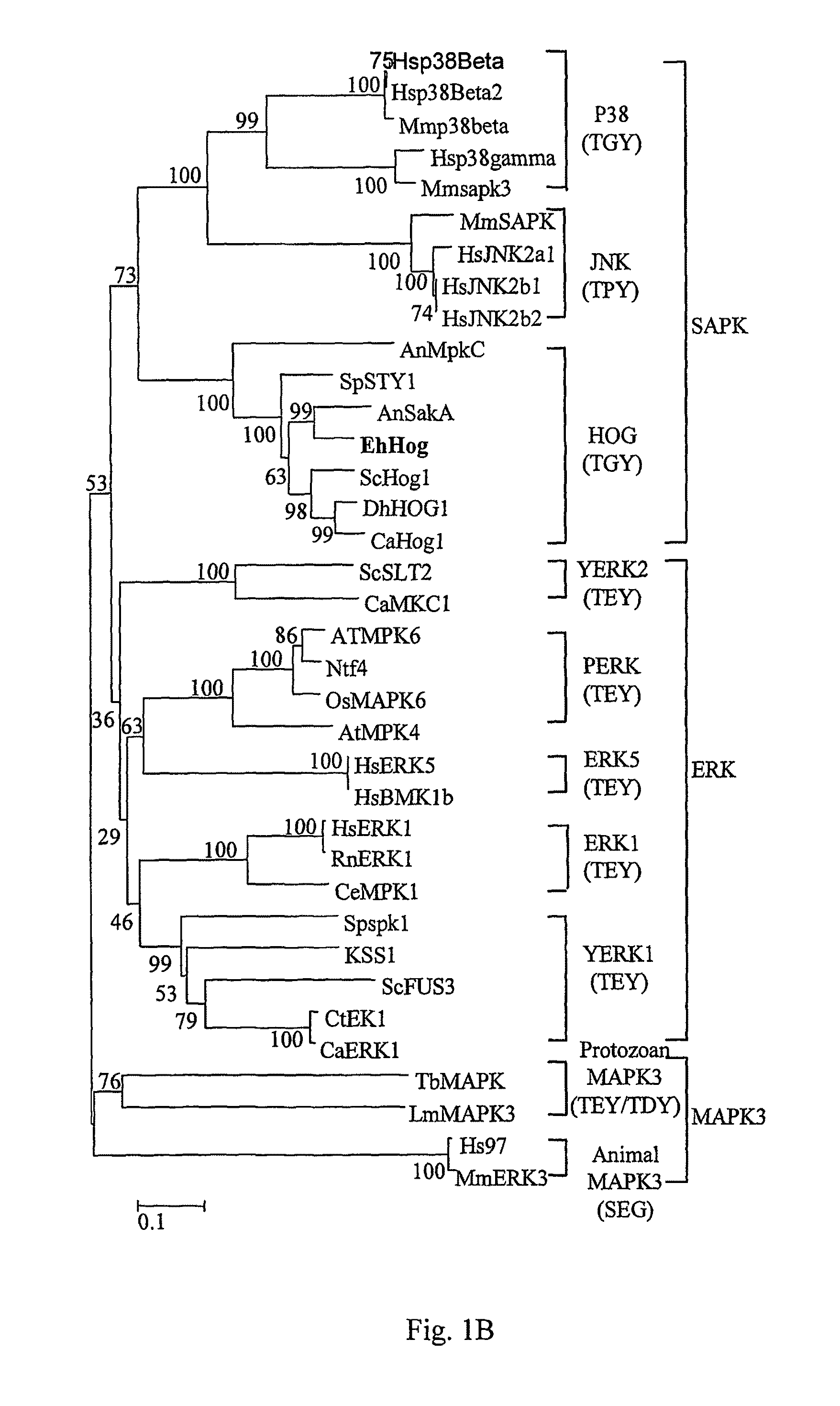Stress tolerant organisms expressing a map kinase homologue
a map kinase and stress-tolerant technology, applied in microorganisms, organic chemistry, enzymes, etc., can solve the problems of no information available in the osmosensing signal transduction pathway in i and cell viability declin
- Summary
- Abstract
- Description
- Claims
- Application Information
AI Technical Summary
Benefits of technology
Problems solved by technology
Method used
Image
Examples
example 1
Isolation and Characterization of the EhHOG from E. herbariorum
[0063]Successful amplification of Hog1 homologue in E. herbariorum was achieved with primers (SEQ ID NOs: 3 and 4) derived from conserved regions of Hog1 from various fungal species available, with flanking regions obtained by chromosome walking (Arnold & Hodgson, 1991). DNA sequence analysis revealed a long open reading frame (ORF) interrupted by eight introns, whose positions were confirmed by sequencing cDNA and genomic DNA clones. This ORF predicted 366-amino acid residues, protein weights of 41.62 KDa, which were highly similar to a kinase from the stress-activated MAPK family. Therefore, the corresponding gene was named EhHOG (Eurotium herbariorum HOG). Sequence alignment revealed that the EhHOG protein shows the highest identity to SakA (81% identity, 86% similarity) from A. nidulans and also shares a high homology to other MAPKs such as Spc1 (78% identity, 87% similarity) in Scho. pombe, Hog1 (66% identity, 72% ...
example 2
Complementation and Overexpression of a S. cerevisiae hog1Δ Mutant by EhHOG in High Salt Stress
[0067]To determine the functions of EhHOG, complementation of S. cerevisiae hog1Δ null mutant (YSH444) was carried out with EhHOG. The salt tolerance of hog1Δ (YSH444 strain) is lower than that of the wild-type strain, because GPDH activity in response to osmotic stress is low when HOG1 (MAP kinase gene) is deleted (Albertyn et al., 1994). If EhHOG could complement the deletion of HOG1 in the S. cerevisiae hog1Δ strain, the osmotic tolerance of the transformant strain should be restored compared with the wild type. The coding region of EhHOG was subcloned into a yeast 2μ vector PADNS and recombinant plasmid (pADNS / EhHOG). DNA was transformed into the hog1Δ (YSH444 strain). The transformants were spotted on plates containing 1M NaCl, 1M KCl, 2M Sorbitol, 0.4M CaCl2, 20% Dead Sea water and 300 mM LiCl (FIG. 3A). The mutant hog1Δ could not grow on these plates, but the transformant strain (YS...
example 3
Resistance of EhHOG Against Generalized Stresses
[0075]In addition to having a role in osmoregulation, EhHOG was found to be involved in responses to generalized stresses, such as heat stress and oxidative stress, in S. cerevisiae (Winkler et al., 2002), in Schizosacharomyces pombe (Degols et al., 1996), and in Candida albicans (Alonso-Monge et al., 2003). During heat stress, the growth of hog1Δ strain recovered more slowly than the wild-type strain (FIG. 6). This is consistent with Winkler's result (Winkler et al., 2002). The transformant (hog1Δ / EhHOG) recovered faster than hog1Δ strain, similar to the wild-type strain (FIG. 6). During oxidative stress, hog1Δ strain was more sensitive than the wild-type strain to H2O2, while the transformant (hog1Δ / EhHOG) showed a similar survival rate to the wild-type strain (FIG. 7B). Our study indicated that EhHOG has similar function to Hog1 in S. cerevisiae to withstand oxidative stress.
[0076]During freeze-thaw stress, the transformant (hog1Δ / E...
PUM
| Property | Measurement | Unit |
|---|---|---|
| depths | aaaaa | aaaaa |
| temperature | aaaaa | aaaaa |
| time | aaaaa | aaaaa |
Abstract
Description
Claims
Application Information
 Login to View More
Login to View More - R&D
- Intellectual Property
- Life Sciences
- Materials
- Tech Scout
- Unparalleled Data Quality
- Higher Quality Content
- 60% Fewer Hallucinations
Browse by: Latest US Patents, China's latest patents, Technical Efficacy Thesaurus, Application Domain, Technology Topic, Popular Technical Reports.
© 2025 PatSnap. All rights reserved.Legal|Privacy policy|Modern Slavery Act Transparency Statement|Sitemap|About US| Contact US: help@patsnap.com



